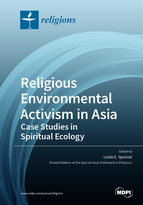Religious Environmental Activism in Asia: Case Studies in Spiritual Ecology
A special issue of Religions (ISSN 2077-1444).
Deadline for manuscript submissions: closed (15 June 2019) | Viewed by 62603
Special Issue Editor
Special Issue Information
Dear Colleagues,
Environmental issues and problems are serious, some are getting worse, and periodically new ones are still being discovered. A multitude of diverse secular approaches to environmental concerns from the local to the global levels certainly have made important progress and are vitally indispensable, such as in the environmental sciences, technology, and conservation as well as in the environmental agencies, laws, and regulations of governments. Nevertheless, secular approaches have proven to be insufficient, this in spite of, among many other things, more than four decades of annual Earth Day celebrations to enhance environmental information, awareness, sensitivity, and responsibility in the USA and other countries. Most secular approaches only treat specific superficial symptoms, rather than the underlying root causes of the unprecedented global environmental crisis as a whole. Also, secular approaches have been insufficient because most ignore the fact that ultimately the environmental crisis as a whole is a spiritual and moral crisis, and that it can only be resolved by radical transformations in the ways that industrial capitalist societies in particular relate to nature. This must involve a profound shift in environmental consciousness and actions which has variously been called the Great Awakening or the Great Turning.
Religious organizations like the Vatican, secular ones like the Worldwatch Institute, and hybrids like the Alliance of Religion and Conservation are exploring and implementing into action ideas about the relevance of religion and spirituality in dealing with environmental issues and problems. Hopefully, these and a multitude of diverse other initiatives engaged in spiritual ecology may help to at least reduce, if not completely resolve, many environmental concerns thereby turning the global environmental crisis around for the better to replace the Anthropocene with the Ecocene, although this may take decades or even longer. Clearly religion and spirituality can be extremely influential for the better at many levels and in many ways through their intellectual, emotional, and activist components.
During this new era recognized by geologists, ecologists, and others as the Anthropocene, with so many grave and urgent environmental problems from the local to the global levels, there are also a multitude of diverse practical initiatives in religious environmentalism addressing the challenges which offer significant potential, hope, and achievements.
This special issue of Religions focuses on providing a set of captivating essays on the specifics of concrete cases of environmental activism involving most of the main Asian religions from several countries. Particular case studies are drawn from the religions of Animism, Buddhism, Confucianism, Daoism, Hinduism, Islam, and Jainism. Countries include Bhutan, China, India, Indonesia, South Korea, and Thailand. Thereby this issue offers a very substantial and rich sampling of religious environmental activism in Asia.
This is a relatively neglected subject in the journal and anthology literature which deserves far more attention. Thus, this issue of Religions begins to help fill a strategic gap. It reveals collectively a fascinating and significant movement of environmental initiatives in engaged practical spiritual ecology. Accordingly, this issue should be of special interest to a diversity of scientists, academics, instructors, and students as well as communities and leaders from a wide variety of religions, environmentalism, and conservation.
Prof. Dr. Leslie E. Sponsel
Guest Editor
Manuscript Submission Information
Manuscripts should be submitted online at www.mdpi.com by registering and logging in to this website. Once you are registered, click here to go to the submission form. Manuscripts can be submitted until the deadline. All submissions that pass pre-check are peer-reviewed. Accepted papers will be published continuously in the journal (as soon as accepted) and will be listed together on the special issue website. Research articles, review articles as well as short communications are invited. For planned papers, a title and short abstract (about 100 words) can be sent to the Editorial Office for announcement on this website.
Submitted manuscripts should not have been published previously, nor be under consideration for publication elsewhere (except conference proceedings papers). All manuscripts are thoroughly refereed through a double-blind peer-review process. A guide for authors and other relevant information for submission of manuscripts is available on the Instructions for Authors page. Religions is an international peer-reviewed open access monthly journal published by MDPI.
Please visit the Instructions for Authors page before submitting a manuscript. The Article Processing Charge (APC) for publication in this open access journal is 1800 CHF (Swiss Francs). Submitted papers should be well formatted and use good English. Authors may use MDPI's English editing service prior to publication or during author revisions.
Keywords
- Religious environmental activism
- Spiritual Ecology
- Asia






